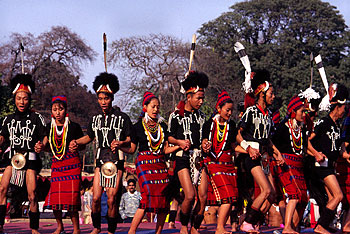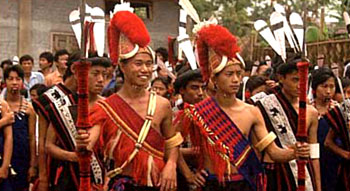 Kiphire District is the newly formed ninth district of Nagaland which was carved out from Tuensang District. Kiphire stands in the middle of the two lofty mountains of Saramati and Jingkhu at an elevation of 896.42 meters above the sea level. This district is located on the eastern part of the state. It is bounded by Tuensang district on the North, Phek district on the South, Myanmar on the East and Zunheboto district in the West. It is headquartered at Kiphire, which is at an altitude of 896 metres above sea level. Kiphire is about 254 km from Kohima, capital city of Nagaland. Total area of Kiphire District is 1255 sq kms. The major cities of this district are Seyochung, Sitimi, Pungro and Kiphire. Saramati, the highest peak in Nagaland, is located in this district. Sangtam (Eastern), Yimchunger and Sema are the predominant tribes of Kiphire District.
Kiphire District is the newly formed ninth district of Nagaland which was carved out from Tuensang District. Kiphire stands in the middle of the two lofty mountains of Saramati and Jingkhu at an elevation of 896.42 meters above the sea level. This district is located on the eastern part of the state. It is bounded by Tuensang district on the North, Phek district on the South, Myanmar on the East and Zunheboto district in the West. It is headquartered at Kiphire, which is at an altitude of 896 metres above sea level. Kiphire is about 254 km from Kohima, capital city of Nagaland. Total area of Kiphire District is 1255 sq kms. The major cities of this district are Seyochung, Sitimi, Pungro and Kiphire. Saramati, the highest peak in Nagaland, is located in this district. Sangtam (Eastern), Yimchunger and Sema are the predominant tribes of Kiphire District.
History of Kiphire District
Kiphire District, which was a part of Tuensang district for years, remained untouched by the British colonial administration even after its subjugation in 1920. Though it was included within the category of Naga tribal areas under Assam and placed under political control, practically, there was neither sign of either political control nor any administration till the transfer of power in 1947. In the wake of expansion of civil administrative out-posts, survey for opening of administrative headquarters was done in 1951. An administrative headquarter was established at Kiphire on 16th of June, 1952. Kiphire District, bifurcated from Tuensang district, was inaugurated on 24th January 2004.
Geography of Kiphire District
Geography of Kiphire District is characterized by a humid and cold climate. During the winter, the temperature sometimes goes down to a very low degree. The lowest temperature recorded during recent years was 2.7 degree Celsius and highest temperature recorded is 37 degree Celsius. Monsoon period extends from June to September and sometimes up to October with an average rain fall of 75 mm. The climate of the district is considered as slightly extreme but healthy.
Demography of Kiphire District
As per 2001 Census, total population of the district is 1,06,136. The people of the district are of Mongoloid stalk and predominantly inhabited by Sangtam, Yimchungru, and Sumi. Besides these, there are six other sub-tribes in Kiphire District. It has 77 recognized villages, 7 townships, 4 compounds with a population of 1,06,136. As the district is inhabited by diverse tribes, the people speak different dialects.
Administration of Kiphire District
Administration of Kiphire District includes three sub-divisions. The main Sub-Divisional Office (Civil) Administrative Headquarters in Kiphire District are Pungro and Seyochung. Five Extra Assistant Commissioner Circle Headquarters in the district are Amahator, Sitimi, Longmatra, Kiusam and Khonsa.
Economy of Kiphire District
 With the majority of the people living in rural villages, agriculture remains the main occupation of the people of the district. Thus, economy of Kiphire District is entirely agriculture based. In spite of favourable climatic condition and fertile soil, primitive method of jhum cultivation is extensively practiced leading to wastage of time, energy and environmental degradation. In spite of the government`s efforts, the agricultural techniques adopted by the farmers are still semi-primitive and pre-industrial. As a result, the output is very low. The main crop of this district is paddy, maize, millet and barley. Cash crops like potato, soyabean and different kinds of local beans are also grown. Poultry and cattle breeding are also practiced in this district, though mostly of traditional method.
With the majority of the people living in rural villages, agriculture remains the main occupation of the people of the district. Thus, economy of Kiphire District is entirely agriculture based. In spite of favourable climatic condition and fertile soil, primitive method of jhum cultivation is extensively practiced leading to wastage of time, energy and environmental degradation. In spite of the government`s efforts, the agricultural techniques adopted by the farmers are still semi-primitive and pre-industrial. As a result, the output is very low. The main crop of this district is paddy, maize, millet and barley. Cash crops like potato, soyabean and different kinds of local beans are also grown. Poultry and cattle breeding are also practiced in this district, though mostly of traditional method.
Culture of Kiphire District
Like in any other part of the state, Kiphire District is rich in culture, custom and practices. Varieties of costumes and traditional dresses, for dancing and chanting folksongs, are found among the people. The rich culture of the district is exhibited during each tribal festival with pomp and gaiety. The Yimchungru tribe celebrates Metemnio in the month of August every year. Sangtam celebrates Mongmong in September. The Sumi celebrates Tuluni in the month of July every year. Folk dance and songs form an important part of the festivals.
Tourism in Kiphire District
There are a number of tourist attraction spots in Kiphire District like Saramati peak, Stone cafe in Khongjiri, Mimi and Salomi villages; Zungki, Tizu and Likhimro Rivers, mining locations in Pokphur and Longpotrok and Fakim Wild Life Sanctuary. A number of traditional houses with stone slates which is rare in other parts of the state are available in Chomi, Mimi, Samphure, Phelungre and Pungro villages. Tourism in Kiphire District means a memorable and enriching experience for the travellers coming from different parts of the world.
Kiphire District takes pride in having Likhmiro Hydro Project under Pungro circle.






